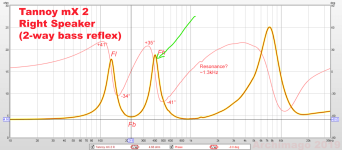Consider the impedance peaks one is port resonance and another woofer resonance in the impedance curve when loaded in the box. Now what happens if you absorb considerable like 80% of the woofer resonance which is second peak of the impedance graph.
First question is : Does it needs to be there? Secondly consider a magic absorber material is there to absorb the peak energy in the second peak frequency then would that be good? what are pros and cons of absorbing the resonant peak at the second peak? in the link provided for reference: http://archimago.blogspot.com/2019/08/measurements-speaker-impedance-part-2.html
First question is : Does it needs to be there? Secondly consider a magic absorber material is there to absorb the peak energy in the second peak frequency then would that be good? what are pros and cons of absorbing the resonant peak at the second peak? in the link provided for reference: http://archimago.blogspot.com/2019/08/measurements-speaker-impedance-part-2.html
Attachments
If you're talking about the upper of the twin LF impedance peaks, you can kill it (as done in the Elsinore & others) with an input LCR Zobel. It can be useful with passive speakers if you're crossing relatively low as the large value series inductor tends to interact with the upper box impedance peak causing some increase in output in the octave immediately above the woofer begins its rolloff. Downside is the components are large value (aka 'expensive') and you need to ensure a reasonably tight tuning, and that it's not going to move around with drive level / any relevant thermal changes.
Consider the impedance peaks one is port resonance and another woofer resonance in the impedance curve when loaded in the box.
Thats not how it goes.
Port (Helmholtz) resonance is represented by impedance minimum between two peaks.
Both peaks are driver resonances in the vented box:
Lower one is Fs with added mass from the port.
Higher one is Fs with added stiffness from the air in the box.
